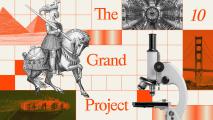A few years ago, $100 million was a remuneration reserved for the founder of an enormously successful company. Now it’s a signing bonus for a top AI engineer.
Mark Zuckerberg has been throwing $300 million pay packages at research scientists in the hope of building an AI talent powerhouse at Meta. Other Big Tech companies are pillaging startups for their top employees, paying off investors and leaving behind the hollow shells of once-promising companies for others to pick over.
One might ask: why this hiring frenzy? The first company to create artificial general intelligence (AGI) — a system that can match or surpass human cognitive abilities across most tasks — could become the most valuable enterprise in history. Sam Altman, in the old days of 2019, said this would “maybe capture the light cone of all future value in the universe, and that’s for sure not okay for one group of investors to have.”
With that prize in sight, the stakes are too high for companies not to go all in — they simply have to push their chips to the middle and pay whatever it takes to get the best talent possible in the hope of being the first to cross the finish line.
This war for talent in AI is unlike anything we have seen before in the business world. The closest parallels are all in other industries.
The top talent playbook
Professional sports teams regularly pay extraordinary sums to attract top talent. The LA Dodgers famously signed Shohei Ohtani for $700 million over 10 years. Lionel Messi’s 2017 contract with FC Barcelona was worth $600 million. Quarterback Patrick Mahomes is getting $450 million over a decade with the Kansas City Chiefs.
Financial firms like Citadel, Millennium, and Jane Street also offer astronomical pay packages to talent, trying to lure prop traders, hedge fund managers, and quantitative researchers to their companies. Though the details of these deals are typically confidential, the figures are similar to the ones we see in sports.
Then there’s entertainment. Movie stars and directors are regularly paid huge sums of money to contribute to projects. These are mostly time and project bound, not quite a continuing employment, but often the contract will include an “exclusivity clause” where the star can’t work with anyone outside the studio for a certain period of time, even if the studio itself isn’t taking advantage of their talents.
The race to AGI is bringing the superstar effect to the world of tech.
In all three of these domains, the firm footing the bill is able to calculate with some accuracy what sort of return on investment it can expect from the talent. In sports, for example, a team might consider how the player will affect its on-field success and then predict how that success could positively affect ticket sales, sponsorships, or merchandising. And if the cost of the talent is less than the value they could bring to the team, an offer is made.
In each industry, there’s an equation, and even if it involves some educated guessing, it’s solvable. These guesses don’t always pan out, of course — Johnny Depp earned $20 million for “The Lone Ranger,” which ended up losing $160 million for Disney — but the model pays off often enough to stick around.
Traditionally, tech hasn’t been like that. It has had superstar teams, superstar companies, and even superstar founders and CEOs, but no actual superstar employees. Despite the widespread appreciation of the 10x engineer, nobody was actually being paid 10x. Being a 10x engineer earned you admiration, not generational wealth. Equity plus salary kept you comfortable, even wealthy, but not dynastically rich.
But the race to AGI is now upending the status quo and bringing the superstar effect to the world of tech.
The model is the product
Many parts of the race to AGI are unprecedented. Extraordinary capital investment — tens of billions of dollars, and soon, hundreds if Softbank and Zuckerberg are to be believed. Extraordinary growth unlike anything we’ve seen before — in less than three years, OpenAI went from $0 in revenue to $10 billion and from no users to more than a billion, across pretty much every country and organisation you could name.
If that was it, though, the AI industry would largely be following the same trajectory we’ve seen cloud startups travel over the past couple of decades, just on a shorter timescale. What sets this situation apart is that the success in AI has largely come on the backs of individuals or very small teams of researchers and engineers.
Small teams are creating tremendous value.
The modern AI revolution started with the eight authors of Google’s landmark “Attention Is All You Need” paper — the “Transformer 8” are now celebrities. One of them, Noam Shazeer, and researchers extraordinaire Ilya Sutskever and Alec Radford were then individually responsible for many of the breakthroughs that have led to transformer models becoming so smart and useful. OpenAI’s GPT-4, the model that shook the world, was built by around 200 people — that’s a group 1/1000th the size of Google.
What’s remarkable isn’t just the size of these teams — it’s the value they’re creating. The transformer block that the “Attention…” authors proposed in 2017 turned out to be incredibly versatile. Though originally proposed for language processing, it’s now the core of systems for protein folding, weather forecasting, chip layout, and even plasma control in fusion reactors.
With so many labs now trying to build the exact same products around their models — chatbot, image creator, coding interface, deep research — the only thing that will set them apart is how well the model itself works. And when the model is the product — and there’s proof you don’t need a lot of people to build the next best model — companies are willing to pay a lot to hire people they think will put them ahead in the race.
AGI or bust
The emerging strategies that companies are employing in this new tech talent war already show some trends, including a few that take their cues from those other industries we’d looked at.
- Better deals. In 1974, the MLB’s reserve clause was overturned, allowing players to enter free agency — this skyrocketed their salaries as teams started competing for top talent. To help them get the best deal, players hired agents. Top AI researchers now have those. Perhaps we could soon see them working “no-trade clauses” into their clients’ contracts — no one wants to be reassigned to the ads team.
- Death of the startup lottery. Hiring great engineers has always been a challenge for startups because Big Tech could pay them triple the salary — it was like an indie studio trying to lure an A-lister away from Warner Bros. With Big Tech now offering to pay 300 or even 3,000 times more, it’s all but impossible. Now that founding a startup is no longer the only way for top talent to become generationally wealthy, the engineer’s dilemma shifts from “Should I quit to start X?” to “Which megacorp’s supercluster do I want to train on?”
- “Creative” talent acquisitions: In 2024, Google paid Character AI $2.7 billion to reverse acquihire — aka, “talent jack” — Shazeer, who had left Google in 2021. That same year, Microsoft reportedly paid more than $1 billion to Inflection AI in order to get its founder, Mustafa Suleyman. Meta is now doing the same, buying a stake in venture capital firm NFDG to bring its founders, Nat Friedman and Daniel Gross, into the fold. It also bought out Scale AI to get its founder, Alex Wang. We will likely see more examples of companies acquiring the talent they want without actually going directly through the talent.
- The studio model: Silicon Valley is already starting to look more and more like Hollywood, with a small cast of elite talent orbiting between cash-rich platforms — Sutskever from Google to OpenAI to Safe Superintelligence; Suleyman from Google to Inflection to Microsoft. Each “production” is funded like a Marvel franchise and protected like a state secret. We could see more of this — exclusive deals, intellectual property silos, and carefully managed stars — as the race to AGI heats up.
- More secrecy, less collaboration. Quant funds already enforce “garden leave” for high-value employees — during this time, those who have resigned or been terminated are kept on the payroll while not working, just so they can’t work elsewhere or share company secrets. How long until Meta or OpenAI demand the same? Big Tech is already far less open than it used to be. There was a time when tech giants shared their best tools — React from Facebook, Kubernetes from Google — so everyone could build faster, but the culture is now flipping to zero-sum: Every token I generate is one you cannot, and every top engineer that works for me is one that isn’t working for you.
This version of the tech industry bears little resemblance to the one that existed just a decade ago, when small companies would try to do hard things, not just because success would mean bigger paychecks, but for the love of the game. People in finance often pride themselves on working for the money, but in tech, it was also about the joy of coding, being creative, and seeing what you might be able to accomplish in a night or weekend.
That’s not to say an engineer can’t still find fulfillment while making nine-figures, but it’s hard to imagine there’s not a difference between shooting hoops with your friends and playing for a national title — the stakes reshape the game. Each win also shakes up your future with the league — better AI models means better AI coders.
As the race intensifies, Silicon Valley is likely to continue adopting the playbooks of industries that have long treated talent as the most critical — and expensive — input. The difference is that this time, the prize isn’t a trophy, a blockbuster, or an alpha-generating strategy. It’s the future of intelligence.
We’d love to hear from you! If you have a comment about this article or if you have a tip for a future Freethink story, please email us at [email protected].






